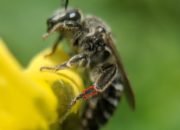Cellophane Bees are generally large, hairy bees most likely to be confused with Honey Bees (Apis melifera) and Mining Bees (Andrena). They are found statewide from early spring till the last asters die in the fall, though no one species is active for more than a month or two. Many are specialists on obscure plants, making them rarely detected.

A large nesting aggregation of Unequal Cellophane Bees © Spencer Hardy
As of March 2021, 10 species in the genus Colletes have been recorded in Vermont, 5 of which have been confirmed through iNaturalist. The Unequal Cellophane Bee (Colletes inaequalis) is ubiquitous early in the spring, and about the time they finish flying, several rare pollen specialists emerge, followed by a group of Asteracae specialist that fly during the goldenrod and aster bloom. Many of the species are communal ground nesters that can form large colonies – look for the “ant hills” with bigger holes.
Genus level ID
While superficially similar to several other genera, Cellophane Bees have multiple distinctive features that will clinch the genus-level ID if they are visible in a photograph. The second recurrent vein (highlighted in red) is S-shaped in this genus and straight in all others. Additionally, look for a slightly heart-shaped face, similar to a Honey Bee, that eliminates most of the Mining Bees (Andrena), which also have hairy facial fovae (females only).
Species level ID
Many species of Cellophane bees can be challenging to ID to species, but knowing the date and flower the bee is visiting can be helpful. The most common spring and fall species can usually be identified with a clear view of the face and thorax.
Spring Cellophane Bees (April + May)

Unequal Cellophane Bee ((Colletes inaequalis)
The most abundant bee in many areas in April and early May. Nest aggregations can have thousands of individuals, making the ground look like its moving! Often found nesting in parks, lawns, and other areas open areas with sparse vegetation.

Blueberry Cellophane Bee (Colletes validus)
So far unrecorded from Vermont, this species is likely present but localized. A sand-nesting species that specializes on blueberries and similar flowering shrubs. The extremely long face is distinctive.

Rufous-backed Cellophane Bee (Colletes thoracicus)
This spring Cellophane Bee is known from southern and eastern Massachusetts, and could potentially be found in southern Vermont. Look for a red-backed, medium-large bee near sandy areas. Image courtesy Jason Gibbs.
Summer Cellophane Bees (June + July)

Broad-footed Cellophane Bee (Colletes latitarsis)
This is one of several bee species best found by developing a taste for salsa verde. This is the most abundant of the Physalis specialist, and is found in most gardens with substantial tomatillo or ground-cherry plantings.

Williston's Cellophane Bee (Colletes willistoni)
Another physalis specialist similar to the Broad-footed. So far only known in VT from one specimen. The length to width ratio of the hind basitarsus is the best way to separate the two species.

Colletes banksi
This is a holly (Ilex) specialist that has not yet been confirmed in VT, but likely occurs somewhere in the state.

Colletes impunctatus
This very rare, northern bee may be associated with huckleberries, but there are too few records to be sure.
Fall Cellophane Bees (August – October)

Spine-shouldered Cellophane Bee (Colletes simulans)
The most abundant and widespread fall Cellophane Bee. Named for a long spine tucked between the head and abdomen, they can also be recognized by the extensive black hairs, short cheeks, and large size.
Colletes americanus
This fall species was first confirmed for the state in 2020. It is less widespread than the Spine-shouldered but probably not rare. Likely impossible to identify from photos.

Goldenrod Cellophane Bee (Colletes solidaginis)
A candidate for the most aesthetically pleasing bee in the state! They are relatively small and covered in short, dense golden hair. Only known from a handful of records, all from areas with significant sand deposits and goldenrod. Image courtesy Michael Veit.

Aster Cellophane Bee ( Colletes compactus )
This species flies late in the fall, which may have allowed it to be overlooked by our Wild Bee Survey efforts, which concluded in late August in the past few seasons. iNaturalist records indicate it is moderately common and widespread in September on Asters. Has a longer face than the other fall Cellophane Bees, most of which seem to prefer goldenrod.
Unless otherwise specified, photos in the grid are courtesy of Margarita Miklasevskaja at PCYU with funding from NSERC-CANPOLIN.
Species not included:
Kincaid’s Cellophane Bee (Colletes kincaidii) – No recent records have been confirmed yet, but a likely kleptoparasite (Epeolus canadensis) was photographed at a Colletes nest in 2019.
Kindred Cellophane Bee (Colletes consors) – No confirmed recent records. A northern species.
Please note that many of our datasets have not been published yet, so the maps are incomplete.













